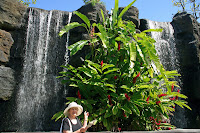Polynesian Cultural Center
The Polynesian Culture Center is the most visited tourist attraction in all the islands. It is a great place to learn the history of our unique 50th state, experience great entertainment, and enjoy a sumptuous Luau with native dan cers and musicians providing one last look at Island history. The food is delicious and there is plenty---seconds and thirds are encouraged.
cers and musicians providing one last look at Island history. The food is delicious and there is plenty---seconds and thirds are encouraged. 
The creation of the double hull canoe enabled the Polynesians to travel over 24,000 miles to settle in the Hawaiian Islands 2000 years ago. They brought with them coconut, sugar cane, and banana seedlings, taro plants (poi), pigs, dogs, chickens, and medicinal plants. The Hawaiian Islands were under a strict caste system. This eventually caused much unrest between the islands and among the various realms reigned over by kings and/or queens. Ki ng Kamehameha, th
ng Kamehameha, th e most powerful ruler and one of the last kings, was able to foster peaceful relations among the other rulers and united the various islands.
e most powerful ruler and one of the last kings, was able to foster peaceful relations among the other rulers and united the various islands.
Hawaii was annexed by the U.S. in 1898 and became a state in 1959. The Mormon Church purchased land, built the Polynesian Culture Center, BYU Hawaii, and a large Mormon temple. Seventy per cent of the employees in the park are students at BYU Hawaii. They are polite, neatly dressed, and well informed in the history of the Islands. The Culture Center tells the story of the various Polynesian influences and how they affected life in the Islands. Samoa
large Mormon temple. Seventy per cent of the employees in the park are students at BYU Hawaii. They are polite, neatly dressed, and well informed in the history of the Islands. The Culture Center tells the story of the various Polynesian influences and how they affected life in the Islands. Samoa , Aotearoa, Fiji, Hawaii, Tahiti, and Tonga are representative of Polynesians who settled in the Islands forming the music, hula, and art that we enjoy today. The Center is somewhat commercial but passes on a great deal of
, Aotearoa, Fiji, Hawaii, Tahiti, and Tonga are representative of Polynesians who settled in the Islands forming the music, hula, and art that we enjoy today. The Center is somewhat commercial but passes on a great deal of  information in a colorful and entertaining format. Exhibits and entertainment depict life as it was on various South Sea Islands before natives departed for Hawaii.
information in a colorful and entertaining format. Exhibits and entertainment depict life as it was on various South Sea Islands before natives departed for Hawaii.
 cers and musicians providing one last look at Island history. The food is delicious and there is plenty---seconds and thirds are encouraged.
cers and musicians providing one last look at Island history. The food is delicious and there is plenty---seconds and thirds are encouraged. 
The creation of the double hull canoe enabled the Polynesians to travel over 24,000 miles to settle in the Hawaiian Islands 2000 years ago. They brought with them coconut, sugar cane, and banana seedlings, taro plants (poi), pigs, dogs, chickens, and medicinal plants. The Hawaiian Islands were under a strict caste system. This eventually caused much unrest between the islands and among the various realms reigned over by kings and/or queens. Ki
 ng Kamehameha, th
ng Kamehameha, th e most powerful ruler and one of the last kings, was able to foster peaceful relations among the other rulers and united the various islands.
e most powerful ruler and one of the last kings, was able to foster peaceful relations among the other rulers and united the various islands.Hawaii was annexed by the U.S. in 1898 and became a state in 1959. The Mormon Church purchased land, built the Polynesian Culture Center, BYU Hawaii, and a
 large Mormon temple. Seventy per cent of the employees in the park are students at BYU Hawaii. They are polite, neatly dressed, and well informed in the history of the Islands. The Culture Center tells the story of the various Polynesian influences and how they affected life in the Islands. Samoa
large Mormon temple. Seventy per cent of the employees in the park are students at BYU Hawaii. They are polite, neatly dressed, and well informed in the history of the Islands. The Culture Center tells the story of the various Polynesian influences and how they affected life in the Islands. Samoa , Aotearoa, Fiji, Hawaii, Tahiti, and Tonga are representative of Polynesians who settled in the Islands forming the music, hula, and art that we enjoy today. The Center is somewhat commercial but passes on a great deal of
, Aotearoa, Fiji, Hawaii, Tahiti, and Tonga are representative of Polynesians who settled in the Islands forming the music, hula, and art that we enjoy today. The Center is somewhat commercial but passes on a great deal of  information in a colorful and entertaining format. Exhibits and entertainment depict life as it was on various South Sea Islands before natives departed for Hawaii.
information in a colorful and entertaining format. Exhibits and entertainment depict life as it was on various South Sea Islands before natives departed for Hawaii.

0 Comments:
Post a Comment
<< Home